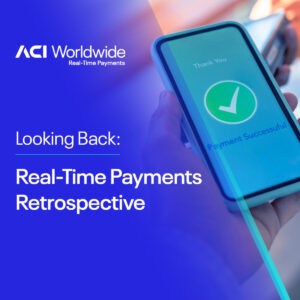Real-time payments growth continues to accelerate around the world. Craig Ramsey, ACI Worldwide’s head of real-time payments, takes a look at the previous forecasts that have under-shot and had to be revised. He also explores the covid-19-related trends that have stuck around and a small selection of industry expectations that have not yet materialised as hoped.
Brazil and the meteoric rise of PIX
The volume of transactions handled by Brazil’s PIX real-time payments system in 2021, its first year of operation, has massively outperformed the forecast of last year’s report (1.8 billion) with an incredible 8.7 billion. Strong adoption (as measured by transaction volumes) was expected, but the scale of overachievement is a testament to the impact of launching new schemes as all-purpose payment services. PIX provides consumer access to real-time payments for almost every scenario in everyday life, allowing it to quickly capture P2P and C2B transactions that would otherwise have been cash-only in a very informal economy.
India: still showing the rest of the world how it’s done
Astronomical real-time payment volumes for India’s UPI interface are not news. What is news, is that growth continues to outperform our forecasters’ best efforts. As a result, we’ve increased our five-year estimates for real-time transaction volumes in India, from 27.5 per cent CAGR in our 2021 report (2020-2025), to 33.5 per cent from 2021 to 2026. Several reasons lie behind UPI’s stunning winning streak. First, it is now the centre of an embedded financial ecosystem that is much wider than simply banking and finance apps. Second, it is able to use this position to create a flywheel effect for innovation, generating new use cases to compound its utility for consumers. For evidence of this, look no further than the major upgrades taking place through 2021 and into early 2022, which will introduce 13 new features including cross-border QR code payments, QR code ATM withdrawals and support for the country’s digital currency, the e-RUPI.
Request to Pay — ready to breakthrough?
Request to Pay (R2P) has been tipped for a breakthrough into the mainstream for some time. Now, R2P is finally riding the global success of real-time payments, gaining popularity as a modern capability aligned with end consumers’ digital expectations. It is safe, secure and brings about more control and visibility for consumers and businesses. It is also considered to be a relatively lower-cost method compared to other payment collection solutions. And it has become an entry-level requirement for new real-time schemes around the world worldwide. With many markets around the world now in possession of the infrastructure and know-how required to make create for a seamless R2P user experience, many of our experts are tipping 2022 to finally be the year. The go-live of R2P in the UK in 2021 shows that even mature markets are continuing to add value to their real-time payments ecosystem.
Peru paves the way for modernisation
Peru is in the early stages of upgrading its first-generation, real-time scheme in response to faster and larger-than-expected growth in real-time payment volumes. The forecast for 2021 was 24 million transactions; this became an incredible actual total of 63.7 million transactions. Among the system updates to the system are a move to genuine immediate clearing and settlement and 24/7/365 availability. With most of the nation’s banks already signed up to the scheme, and a concerted effort underway to bring down the country’s unbanked population, this is expected to almost immediately unlock yet more additional growth. But, more broadly, Peru’s experience is illustrative of the modernisation needs of first-generation, real-time schemes. Many of these have suddenly experienced rapid growth due to changing consumer expectations and a covid boost to adoption. This in turn has laid bare the need to modernise in line with technological advances since they first launched (such as mobile banking and ISO 20022).
B2B real-time payments still to take off
Despite several years of expectations that real-time B2B payments would take off and solidify revenue-generating opportunities, usage remains low. Transaction limits are one culprit, with generally low limits still making the expensive RTGS system the only viable option in many cases. Corporate B2B payments are also typically a high-care service with repair, verify and extra security checks, which are valued by corporates; while real-time payments have less touchpoints and can be considered more consumer-focused by banks. And with RTGS services carrying a higher margin, it would be little surprise if banks were protective of them (though this wouldn’t be sustainable for long, as customer awareness of cheaper and faster services grows). Ultimately, the business case for real-time payments is as much about staying relevant with customer expectations as it is about driving revenue. So rather than corporates having to forego the high-care RTGS experience in exchange for the benefits of real-time payments, they should have the flexibility to choose based on different payment needs.
Image and article originally from thefintechtimes.com. Read the original article here.


